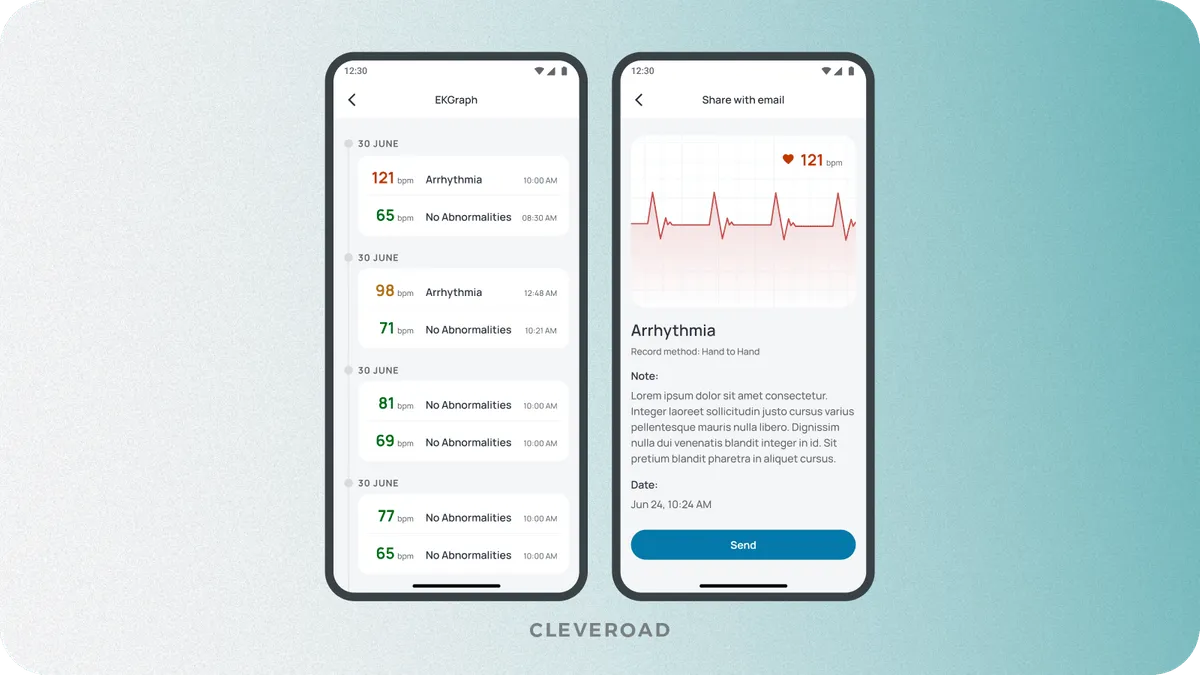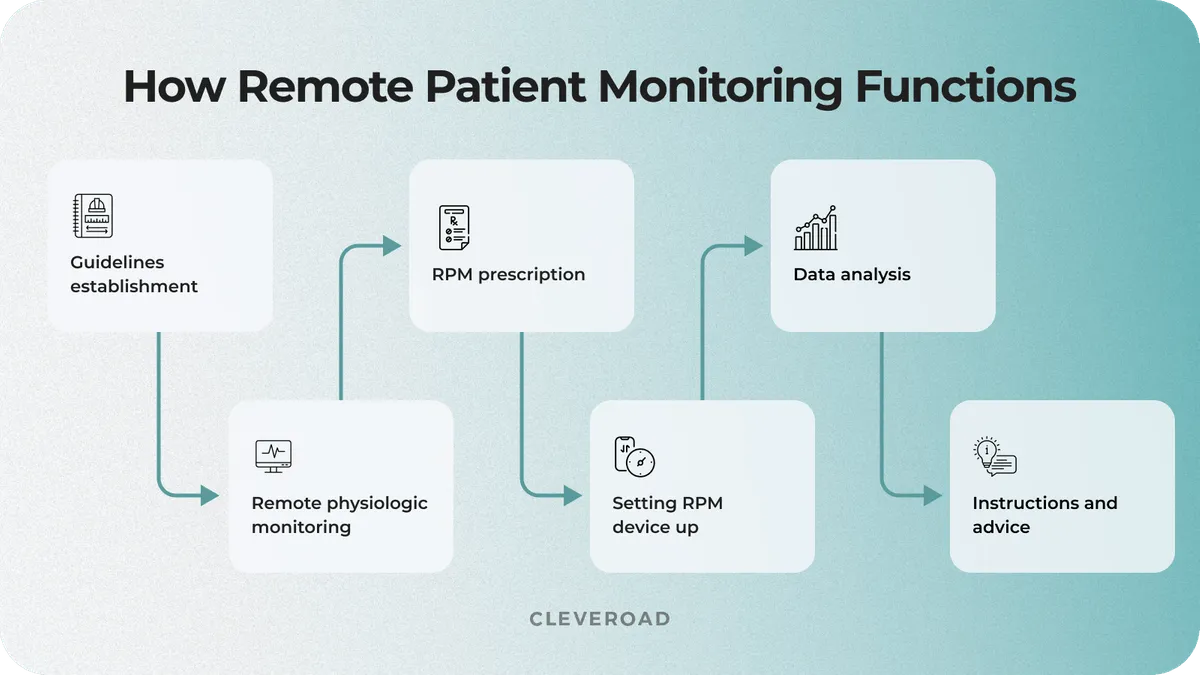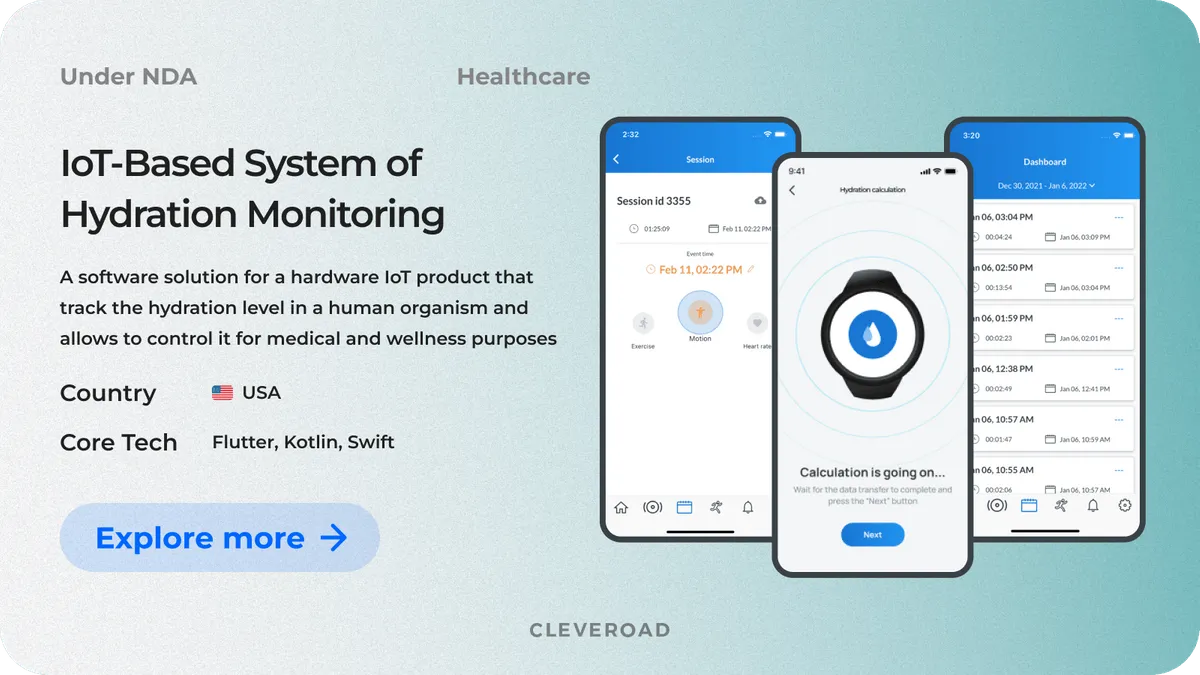What Is Remote Patient Monitoring: The Full Guide for 2025
Updated 11 Mar 2024
13 Min
1543 Views
Remote patient monitoring in hospitals gives the medical providers the capability to remotely monitor patients' vital signs, symptoms, and overall health status whenever they are. This innovative technology not only enhances patient convenience but also allows for early detection of potential health issues, leading to proactive interventions and improved outcomes.
As an IT provider with 12+ years of experience in healthcare software development, we systematized all the basics you should know about the remote patient monitoring software: its working principles, popular RPM devices to use, benefits of RPM program use to implement, and many more.
What Is Remote Monitoring in Healthcare?
Remote Patient Monitoring (RPM) is a common telehealth tool used to provide long-term care to sick people, particularly post-discharge or elderly individuals. It connects healthcare providers with high-risk patients to monitor their health status and track important data (e.g., weight, blood glucose/pressure, heart rate) between visits with the help of RPM devices and the specialized software. Businesses can also utilize remote medical monitoring to track workers' compensation cases and support employees in returning to work effectively.
Remote therapeutic monitoring is a promising method of providing therapy and delivering medical services. By analyzing the statistics, we can conclude that the RPM solutions will continue to find their application in medical institutions and in the healthcare industry as a whole.
For example, Juniper Research states that the RPM technology users will reach 115 million throughout the world (which is equal to 1.4% of the total population) by 2027, when in 2023 it was only about 75 million.
What do they track? We’ll answer with the example of the United States: according to the Fighting Chronic Disease report, the US spends $2.2 trillion for healthcare needs every year, and 75% of this sum goes to chronic disease monitoring. These expenditures pay off: as to the Strategic Market Research data, the US patients participating the RPM programs, visit doctors on schedule for 47% less than usual. The number of emergency visits of patients to physicians also falls by 51% due to timely tracking of the vital signs of the patients by the remote patient monitoring devices.
Popular Remote Patient Monitoring Devices
Let's talk more about the key RPM devices that help the technologies, such as IoT in healthcare, telehealth, AI/ML, etc. bridge the gap between healthcare providers and patients, enabling continuous and real-time monitoring of vital signs (e.g., monitoring of blood pressure, blood oxygen levels, cardiac monitoring), symptoms, and treatment adherence through the remote patient monitoring system from the comfort of patients' homes.
Smart wearables
Smart wearables empower patients to actively use remote patient monitoring and participate in their healthcare management while promoting a more proactive approach to wellness. These devices (e.g., the Apple Watch and Fitbit) offer advanced health-tracking features, including heart rate monitoring, activity tracking, and even ECG functionality. This way, they enable patients to monitor their health continuously, providing valuable data to healthcare professionals. The seamless integration with smartphones allows for real-time data transmission and alerts, ensuring prompt responses to any concerning health indicators.
Blood pressure monitors
Remote blood pressure monitors, often equipped with telehealth capabilities, enable patients to measure and transmit their blood pressure readings to healthcare providers without the need for in-person visits. People with chronic conditions, such as hypertension, benefit from the convenience of the patient remote monitoring of their blood pressure at home, promoting better adherence to treatment regimens and reducing the risk of complications.
Continuous glucose monitors
Continuous Glucose Monitoring devices such as Dexcom or FreeStyle Libre offer patients with chronic diseases (e.g., diabetes) the ability to monitor their glucose levels continuously, eliminating the need for frequent finger stick tests. These RPM devices transmit data wirelessly to smartphones or dedicated receivers, allowing healthcare providers to track trends, make changes in treatment plans through the digital health system, and intervene promptly in case of abnormal readings.
ECG monitors
Smart wearable ECG monitors are valuable remote patient monitoring tools for individuals with known or suspected cardiac conditions, such as arrhythmias or atrial fibrillation, as well as for monitoring heart health during physical activity or daily life. Early detection of abnormal heart rhythms can help prevent serious complications, such as stroke or heart failure, and facilitate timely intervention by healthcare service providers.

Example of a Remote Patient Monitoring (RPM) feature for ECG monitoring developed by Cleveroad
Pulse oximeters
Pulse oximeters measure oxygen saturation levels in the blood, providing a crucial indicator of respiratory function. Patients with respiratory conditions, such as Chronic Obstructive Pulmonary Disease (COPD) or asthma, can use pulse oximeters to track their oxygen levels regularly. In the context of remote patient monitoring, these devices help healthcare providers assess the severity of respiratory issues, adjust treatment plans, and intervene promptly if oxygen saturation levels fall below the normal range, improving the health outcomes.
How Remote Patient Monitoring Works
The RPM devices’ work is deeply connected with the specialized software that processes, analyzes, and presents the data collected from patients. Let's consider the fundamentals of how the RPM workflow passes in the medical establishments to give you more understanding of the comfortability of this process and why you should take remote patient software implementation steps in your clinics.
How does remote patient monitoring work? Everything starts with healthcare providers establishing guidelines for the distant patient health conditions management, implementing remote patient monitoring programs and offering RPM services to patients.
Based on the provider's assessment, the patient is eligible for remote physiologic monitoring, which can collect more types of health data. With the patient's consent, the provider may proceed to prescribe RPM. After this, patients typically obtain a device to collect health data. These devices (e.g., blood pressure monitors, sensors, weight scales, etc.) are usually connected electronically through cellular networking or Bluetooth. Once the RPM device is properly set up, it efficiently collects and transmits health data from the patient to the provider, usually through electronic methods.
Finally, the provider analyzes the collected health data and offers the patient health and wellness advice and instructions based on the results. Once the physicians have analyzed the collected health data, they offer the patient health and wellness advice and instructions based on the results. This comprehensive approach allows for timely interventions and adjustments to treatment plans, ultimately leading to improved patient outcomes and satisfaction.
What is more, remote patient monitoring helps avoid disruptions in healthcare delivery for patients on RPM by providing continuous oversight and timely interventions, thereby minimizing the risk of medical emergencies and unnecessary hospitalizations.
Moreover, remote patient monitoring caters to diverse patient populations, including those with chronic conditions or those requiring post-operative care, ensuring that monitoring will continue to play a vital role in healthcare delivery. Patients and healthcare providers alike can benefit from learning more about RPM and its potential to enhance patient care and outcomes across medical settings.

RPM operating logic
Healthcare Remote Monitoring Benefits
Below you may find some valuable benefits brought by the remote monitoring healthcare platforms both for healthcare providers and patients.
RPM benefits for healthcare establishments
Decreasing operational costs. Increased usage of the RPM solutions prevents the need to reach the healthcare establishment on a daily basis physically. Therapists can track the patients' health state remotely and provide essential appointments via a handy application.
Chronic health issues monitoring. Distant patient caring solutions and gadgets are able to help cut down costs by assembling a range of client-generated records. Having such data on hand, physicians are able to monitor the chronic illnesses' current conditions and assess their dynamics to prescribe proper treatment.
Reduced load towards the medical sector. The workload taken over by medical establishments can be processed via the remote patient monitoring systems. They efficiently cut down the employees' strain at diverse enterprise levels within the healthcare sector.
Developing medical business potential. Regardless of the financial contribution requirement for the software development as well as all the obligatory equipment provided, the costs will be quickly recouped due to the RPM solidity and robustness. Remote patient monitoring is a tool that optimizes the medical services delivery and will bring expanded opportunities unavailable prior to the technology's implementation.
Moreover, by integrating a virtual waiting room healthcare module in your RPM solution, you can highly increase patient safety and eliminate the risk of spreading infections.
Remote patient monitoring advantages for patients
What is remote health monitoring? Primarily it implies a high client orientation. Thus, patients also benefit from this technology as described below.
24/7 remote support regardless of location. The RPM software delivers online data regarding medical indicators per patient. As a result, people are able to contact their doctors and receive a consultation at any time and from any point on the map.
Personal medical data accessibility. With remote patient monitoring (RPM) systems, patients are able to see the dynamic therapy and prescription details through the user-friendly system. Comprehensive insights allow the audience to receive more information concerning the treatment and the individual health records.
Travel necessity elimination. The homecare approach successfully liquidates the need to spend time getting to the medical institution. Even in case the clinic placement is far, RPM's high accessibility enables conducting consultations online without binding to the specific place to attend for medical recommendations’ receiving.
Remote Patient Monitoring Market Examples
The modern medical market has a diversity of successful remote patient monitoring healthcare solutions, and we’ll consider some examples of remote software for tracking health.
HealthSnap
HealthSnap is a large remote medical monitoring solution. The main purpose of HealthSnap is to enable patients to communicate with medical providers via a handy solution. This solution offers the following key features as: virtual care communication, secure medical data assembly, chronic health problem management, etc.
HealthSnap has obtained high credibility among the audience for secure medical data assembling and processing. Doctors apply this platform to provide efficient and accurate therapy to clients suffering from chronic health problems.
Vivify Health
Vivify Health integrates interrelated gadgets and other solutions, allowing to monitor patients' medical indicators distantly through the core functionality like customizable alerting, personalized patient portals, secure patient data storage and management. The organization also assists clients having a range of health issues, like diabetes and asthma, engaging medical tools such as handled blood pressure cuffs and wireless weight scales in its service.
CareSignal
CareSignal allows detecting increasing risk by remote monitoring of patients. This solution's main goal is to increase vendor operation within value-based care. The robotized and scalable solution provides an opportunity for real-time patient monitoring, value-based care optimization, risk detection algorithms and so on.
Dive deeper into remote patient monitoring software development with our guide!
Choosing Remote Patient Monitoring System
Developing a remote patient monitoring system, you have two options:
- Choose a ready-made RPM solution
- Create a remote patient monitoring software from scratch
Choosing ready-made RPM
The ready-made medical device remote monitoring solutions may cost lower and be easy to implement, but have limited functionality that may not fully cover all your business requirements. The usage of ready-made software reduces the security of patient monitoring data since you primarily depend on a third party. Such a substantial disadvantage may lead to insufficient protection from hacking activities and the subsequent losses in finance and trust.
RPM system development from scratch
Creating a healthcare solution for remote monitoring helps you create software that fully reflects your hospital’s needs, from scratch. This approach considerably increases the quality of the RPM (Remote Patient Monitoring) solution and makes it competitive. Keep in mind that custom RPM system’s architecture, feature set and an intuitive UI/UX design can be completed successfully only in partnership with an IT vendor who has a solid experience in the telemedicine software development services.
In order to find a reliable healthcare IT provider, you can outsource healthcare software development. This is a great option to get all the benefits of custom development of a patient remote monitoring system at a reasonable cost. The average price of the RPM software system ranges from $200,000 to $400,000+, but the skilled health software development team, like one at Cleveroad, understands the importance of delivering value within budget constraints. With our expertise in creating remote patient monitoring systems, we prioritize efficiency and cost-effectiveness without compromising on quality. By leveraging our experience and innovative approach, we strive to deliver customized RPM solutions that meet your health establishment’s unique needs while ensuring optimal return on investment.
To give you a hint about the price constituents, we’ve created a table with a team composition you may need to create an RPM monitoring system, and the hourly rates for these specialists work across the most popular outsourcing destinations.
| Outsourcing IT experts specification | Central&Eastern Europe | Western Europe | North America | Latin America | Asia | Africa |
Developers | $50 - $60/h | $30 - $65/h | $80 - $100/h | $35 - $70/h | $20 - $45/h | $25 - $45/h |
UI/UX Designer | $35 - $45/h | $30 - $50/h | $70 - $80/h | $40 - $60/h | $20 - $30/h | $20 - $30/h |
Project Manager | $50 - $70/h | $30 - $50/h | $70 - $80/h | $40 - $60/h | $20 - $30/h | $25 - $35/h |
Business Analyst | $25 - $35/h | $25 - $45/h | $60 - $75/h | $35 - $60/h | $15 - $25/h | $20 - $30/h |
QA Specialist | $25 - $40/h | $25 - $45/h | $60 - $75/h | $35 - $60/h | $15 - $25/h | $20 - $30/h |
DevOps | $30 - $50/h | $30 - $65/h | $80 - $100/h | $35 - $70/h | $20 - $45/h | $25 - $45/h |
Team Lead | $45 - $55/h | $45 - $65/h | $85 - $110/h | $45 - $80/h | $35 - $45/h | $30 - $45/h |
When applying to outsource, you should keep in mind that the higher price, like one for North American specialists’ services, doesn't reflect the same performance. You may select the region with adequate costs yet, get the remaining top-class services' quality. For example, Central and Eastern Europe (particularly, Estonia) is a solid tech hub with many developers possessing solid expertise in healthcare software development. If you outsource your RPM project to this country, you will be delivered with an RPM solution of the highest quality, meeting all your individual requirements.
Cleveroad Experience in Remote Patient Monitoring Technology
Cleveroad is an outsourcing HealthTech company with in-depth experience in remote patient monitoring software development services. Our expertise includes delivering healthcare software focusing on IoT, embedded technology, automation, telehealth, and AI. Our health solutions empower medical businesses by seamlessly integrating IoT-based devices, utilizing embedded technology for efficient data processing, enabling automation to streamline workflows, facilitating telehealth services for remote patient care, and harnessing the power of the artificial intelligence for data analytics and personalized healthcare insights.
Let us prove our competence in creating telehealth software integrated with RPM technology by introducing one of our projects. We’ve designed the IoT-based system of hyman hydration monitoring in real-time.
Our customer is a US-based scientific and commercial company that provides an loT-based telecare solution for tracking human hydration levels. They required a telecare solution connected with IoT sensors that enables users to track hydration indicators from mobile devices, complying with the 510 (k) FDA Medical Device Registration guidelines.
Our team has designed and built an RPM monitoring system that enables users to monitor hydration levels from mobile gadgets available on any operating system. Besides, our tech engineers have provided the integration with the client’s Paas (Product-as-a-Service) platform and an obligatory compliance. In addition, our experts delivered maintenance and support services to our client allowing us to extend the current network of partner enterprises.
As a consequence, our client got a convenient cross-platform integrated with data synchronization and PaaS. Moreover, the solution is developed due to the current US legislation, and the customer can freely and legally use it while rendering their services.
Build an RPM-based system with our domain experts
Contact us, our healthcare IT specialists will consult you and provide you with full-fledged telehealth software development services to integrate RPM into your telehealth solutions
This technology stands for a type of homecare digital system that enables clients to apply mobile medical gadgets and software solutions to assemble patient-generated health data (PCHD) for further transmission to medical providers and consultation. Therefore, patients individually track and record the health-related data at diverse points on a daily basis. After that, it is securely delivered to their therapists. Healthcare organizations can then use this data to monitor patient health and provide appropriate care, while ensuring accurate remote patient monitoring billing and reimbursement, particularly through programs like Medicare, which offer reimbursement for remote patient monitoring services as outlined by the Centers for Medicare & Medicaid Services (CMS).
A remote patient monitoring device is a vital component of a digital health system, enabling healthcare providers to improve patient care through remote monitoring services. The use of RPM devices allows for continuous tracking of patient health metrics outside traditional clinical settings, facilitating proactive interventions and enhancing overall patient outcomes.
The primary equipment often includes wireless sensors measuring various physiological indicators, such as electrocardiograms, blood pressure, blood sugar, weight, blood oxygen, and heart rate. Examples of use of RPM devices encompass blood glucose meters, and the use of remote physiologic monitoring services helps assemble and integrate these records into digital repositories, facilitating patient education and enhancing overall healthcare outcomes.
Telehealth refers to the broader provision of healthcare services remotely, often including video consultations, telemedicine appointments, and virtual care delivery. In contrast, remote patient monitoring (RPM) specifically focuses on the continuous monitoring of patient health metrics outside of traditional clinical settings. For instance, patients with high blood pressure can use RPM devices to track their blood pressure readings regularly, allowing healthcare providers to benefit from remote data monitoring and intervene as necessary.
Remote Patient Monitoring (RPM) involves a systematic process initiated by healthcare providers and guided by established criteria from organizations like the Center for Connected Health Policy and the Agency for Healthcare Research. These guidelines determine patient eligibility for remote physiologic monitoring. Once deemed suitable, patients receive prescribed RPM devices, such as blood pressure monitors and sensors, which connect electronically through cellular networks or Bluetooth. This interconnected system ensures seamless data transmission to healthcare providers, facilitating continuous oversight. The value of remote patient monitoring lies in its ability to offer timely interventions, personalized care, and improved patient outcomes, emphasizing the ongoing and essential coverage of RPM in modern healthcare practices.
The most popular remote patient monitoring method is the home monitoring program, which utilizes various devices to track patients' health remotely. Monitoring can help healthcare research and quality by providing continuous data on patients' conditions outside of clinical settings. Additionally, the use of devices in remote monitoring enhances patient adherence to treatment plans and allows for timely intervention by healthcare providers when necessary. Furthermore, a successful RPM program extends patient care outside traditional healthcare settings, catering to a diverse range of patients and ensuring comprehensive and personalized healthcare management.
It’s recommended for leveraging remote patient monitoring (RPM) for individuals requiring continuous monitoring outside traditional healthcare settings. RPM allows healthcare providers to track patients' vital signs, symptoms, and other health data remotely, making it suitable for those with chronic conditions or post-surgery recovery needs. Monitoring may include patients with conditions like hypertension, diabetes, or cardiac issues, enabling proactive management and timely interventions.

Evgeniy Altynpara is a CTO and member of the Forbes Councils’ community of tech professionals. He is an expert in software development and technological entrepreneurship and has 10+years of experience in digital transformation consulting in Healthcare, FinTech, Supply Chain and Logistics
Give us your impressions about this article
Give us your impressions about this article
Comments
1 commentsbest article
